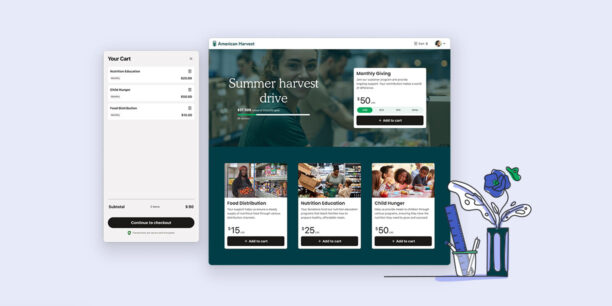What Is Corporate Social Responsibility?

Request a Demo
Learn how top nonprofits use Classy to power their fundraising.
Rising corporate social responsibility (CSR) presents an opportunity for nonprofit organizations to strengthen bonds with like-minded businesses and amplify a combined impact.
As employees, stakeholders, and customers become more vocal about their desire to see CSR in action, corporations and nonprofits must seek each other out and connect on shared visions and values to outline unique corporate giving opportunities that help everyone win.
We’ll help you understand what CSR programs are and how you can use this growth opportunity to establish meaningful partnerships with top corporations nationwide.
Corporate Social Responsibility (CSR) isn’t required, but it is a growing expectation for for-profit businesses to create value beyond the bottom line. Instead, CSR intends to introduce achievable and long-term outcomes to nonprofit and for-profit organizations that make the world a better place.
Companies may create special CSR projects, start a movement, connect to an existing cause and organization, or choose to empower employees to take action on any cause that matters most to them.
Examples of Corporate Social Responsibility
There are several types of CSR that business leaders can prioritize. Areas of focus center on the industry, stakeholders, and market where an organization can gain a competitive advantage with customers. The following key areas are where many businesses develop CSR strategies:
- Environmental responsibility: The belief is that organizations should opt for the most environmentally friendly behavior possible, from sustainability and reducing potentially harmful practices (like pollution or carbon footprint) to regulating emissions and energy consumption. This can also mean offsetting negative environmental impact by funding research, donating to environmental nonprofits, and getting involved with environmental actions, such as planting trees or cleaning local parks.
- Ethical responsibility: The expectations of business practices are fair and ethical in treating stakeholders, leaders, investors, employees, supply chains, and customers. Ethical behavior may also mean creating standards for products, ingredients, materials, or components and sourcing according to fair-trade regulations.
- Philanthropic responsibility: The sentiment businesses take to play an active role in making the world a better place through donations, volunteerism, and long-term partnerships with nonprofits that align on missions. Organizations can donate a portion of earnings, match employee-giving amounts, get involved in campaigns, and sponsor fundraising events.
The Growth of Corporate Social Responsibility in the United States
Increasingly, it’s becoming crucial for businesses to establish and showcase CSR efforts to various stakeholders to gain their trust and respect. Modern consumers are far more conscious of topics such as climate change, health care disparities, and social inequalities, which translates into higher expectations of the businesses they work for and shop from to echo that education and understanding.
We see the same patterns of topics reflected when we looked at the top current events that drove donors to give in 2022: international human rights crises, climate change, reproductive rights and women’s health, and disability rights. These expectations continue to fuel more extensive, creative, and permanent CSR initiatives. This gets at the heart of social impact: informing business strategies that gain loyalty from the new generations of customers and employees that determine success.
A recent study found that 76% of companies report on CSR to reduce brand reputation risk, and 83% of employees would consider leaving their jobs if the company displayed irresponsible CSR practices.1
One of the easiest ways for companies to maintain a strong CSR program is to build relationships with trusted nonprofits. These charitable organizations already have fundraising initiatives, events, campaigns, and donation processes that support greater communities in need.
Corporate leaders want to make the right decision before signing a formal partnership agreement, just like nonprofits need to be cautious about potential partners for the sake of reputation. To help expedite the process and get your organization on the radar, consider proactively pitching a corporate partnership to add value to your team and theirs once you’ve identified them as a strong match.
Corporate partnerships serve as a long-term solution for CSR growth and an expansion strategy for your nonprofit’s mission. Everyone wins when you present a mutually beneficial relationship to a for-profit business you feel good about partnering with on shared goals.
Let’s explore how you can impress a room of executives with a well-thought-out pitch.
How to Pitch Partnerships to Businesses
1. Find the Right Organizations
Start by narrowing down a handful of organizations to pitch your nonprofit to, knowing you may want to work with a few. While revenue and brand names feel like the most important determinants of your decision, look beyond the surface and into the heart of an organization to find the best fit. You can also choose organizations that employ and serve demographics that match your ideal donor base, knowing the exposure and awareness opportunities that lie ahead.
Then, explore social media channels, websites, and press coverage to learn about an organization’s personality. One example of company research that can help you understand how to frame your pitch is looking for a dedicated environmental, social, and governance (ESG) page like this one from Starbucks. When you know what matters to a business, you can find common ground for building a relationship.
Pitching a socially responsible company with a long-term commitment means looking at how well the organization will grow with your nonprofit and honoring the aspects that make you unique. If you pitch multiple organizations, personalize your message to showcase the thoughtfulness that went into selecting them for a meaningful first impression.
Explore Socially Responsible Companies
2. Present Multiple Options
The best way to engage corporate partners is to be ready with various ways to get involved in your organization. Here are a few options to include in your pitch based on your priorities, the campaigns that lead to the best results for your organization, and the CSR program they currently have:
- Direct giving: Present a customized crowdfunding campaign that helps a business tell your story and celebrates donors’ positive impact in real-time, with co-branding that elevates them and their reputation.
- Gift matching: Show leaders how simple it is to establish employee gift matching and its benefit for employee engagement to retain those who want to feel their organization’s support. When you have an accessible way to establish donation matching and easily track performance across the organizations you pitch, you can present a competitive edge.
- Event sponsorship: Create tailored sponsorship packages to attract businesses with the reputation benefits of attaching their brand to your larger efforts or hosting a unique event created just for them. It could be helpful to include a branding mock-up across your event materials to emphasize how simple this option can be for them to incorporate.
- Peer-to-peer fundraising: Show off a way to involve the whole team. This is another great way to mock up a co-branded peer-to-peer fundraising campaign to show businesses how simple it is to share across staff. You can make it fun by setting a company-wide goal and having teams or groups compete to raise the most, tapping into their friends and family for the greatest support.
When your partnership opportunities align with CSR strategies the organization has expressed interest in, leaders can start to envision the value of a partnership more clearly.
3. Create a Repeatable Strategy
Businesses are all about long-term thinking, which means showcasing the longevity of a nonprofit partnership is essential. One way to do this is to emphasize how easy it is to spin up new campaigns unique to the business and its branding.
Campaign templates for crowdfunding and peer-to-peer campaigns are a great asset for the organization to establish an annual fundraising effort. It’s also an excellent tool to help run seasonal campaigns, such as a spring event. Businesses will appreciate that you help them showcase a more consistent philanthropic influence without additional effort.
You can also edit permissions within a campaign template on Classy and lock elements you don’t want to change. That helps you offer autonomy to the marketing, public relations, or human resources teams that may lead your partnership efforts on the business side. Pair that with the reporting and metrics available on each campaign, and you have a solid formula for a long-term partnership built to scale with CSR program demands.
4. Encourage Employee Engagement
As you solidify your pitch, reiterate the value of employee engagement with opportunities to get people involved. Remember, modern younger employees want to do more than donate passively to a good cause. They want to be intimately involved in the cause and understand how their contribution influences the bigger picture.
This is a beautiful place to highlight volunteerism, employee fundraising, and donation matching as key components of the organization’s talent attraction and retention strategies. Help businesses envision how to display your partnership on career sites, in job descriptions, and within employee onboarding materials.
Not only does this appeal to an important topic for many businesses, as employee turnover remains a risk, but it also solidifies the partnership and loyalty of an entirely new donor base for your organization that can stay with you even if they move jobs in the future.
Strengthen Your Nonprofit Corporate Giving Programs
Present Your Strongest Corporate Partnership Pitch
Your corporate partnership pitch can meet the moment of heightened CSR efforts. With a repeatable, mutually beneficial process for driving direct donations, storytelling, and employee engagement, your nonprofit is in a prime position to land trusted corporate partners.
Classy’s comprehensive fundraising platform makes corporate partnerships easier by:
- Customizing co-branded crowdfunding campaigns that tell your story and celebrate donor impact to encourage giving
- Tailoring sponsorship packages for organizations to include their branding on your event page, virtual venue, and event swag or auction items
- Empowering employees to fundraise on your behalf with peer-to-peer fundraising and corporate gift matching to make their gifts go further
We help you remove the barriers and elevate your cause with an audience of supporters ready to form fruitful, long-term relationships.
Learn more about the thousands of nonprofits that choose Classy to power corporate partnerships and the tools available to bring your vision to life.
Copy Editor: Ayanna Julien
Article Source
- “Essential Corporate Social Responsibility Statistics in 2023,” ZipDo, accessed September 5, 2023, https://zipdo.co/statistics/corporate-social-responsibility/.

Get the Tech Created to Support Corporate Partnerships
Subscribe to the Classy Blog
Get the latest fundraising tips, trends, and ideas in your inbox.
Thank you for subscribing
You signed up for emails from Classy
Request a Demo
Learn how top nonprofits use Classy to power their fundraising.
 Explore Classy.org
Explore Classy.org 

